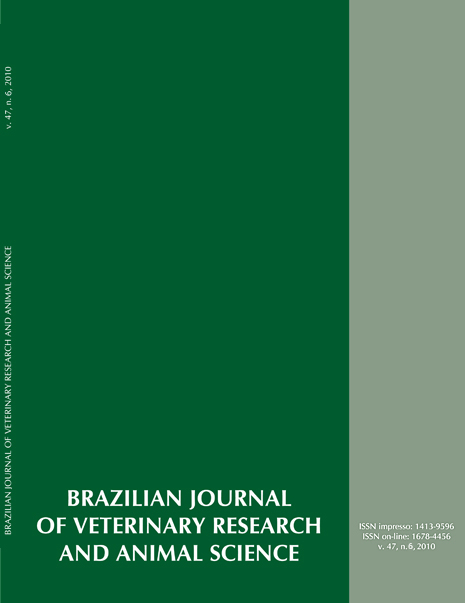Oxidative metabolism in copper poisoning sheep treated with tetrathiomolybdate and/or antioxidative vitamins
DOI:
https://doi.org/10.11606/issn.1678-4456.bjvras.2010.26803Keywords:
Vitamin C, Vitamin E, Copper cumulative poisoning, Oxidative Stress, Amonium tetrathiomolybdate (TTM)Abstract
The effects of vitamins C and/or E associated to amonium tetrathiomolybdate (TTM) in the treatment of cumulative copper intoxication (ICC) in sheep were analyzed throughout oxidative metabolism. Reduced glutathione (GSH), malondialdehyde (MDA), uric acid and the ferric reducing ability of plasma (FRAP) concentrations were evaluated. Twenty four male sheep, Santa Ines breed, with 25 kg BW was distributed in four treatments: TTM, TTM and vitamin C (TTM+VC), TTM with vitamin E (TTM+VE) and TTM with vitamins C and E (TTM+VCE). The intoxication status caused an intensive formation of free radicals with reduction of the GSH concentration and increase of MDA. Despite the increase in the capacity of plasmatic antioxidant observed with the increase of uric acid and FRAP concentrations, it was not observed any benefit with treatments using oxidant vitamins, isolatedly or together with classic treatment only with TTM.Downloads
Download data is not yet available.
Downloads
Published
2010-12-01
Issue
Section
UNDEFINIED
License
The journal content is authorized under the Creative Commons BY-NC-SA license (summary of the license: https://
How to Cite
1.
Weigel RA, Ortolani EL, Sucupira MCA. Oxidative metabolism in copper poisoning sheep treated with tetrathiomolybdate and/or antioxidative vitamins. Braz. J. Vet. Res. Anim. Sci. [Internet]. 2010 Dec. 1 [cited 2024 Apr. 19];47(6):421-8. Available from: https://www.revistas.usp.br/bjvras/article/view/26803





